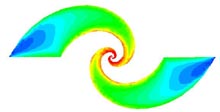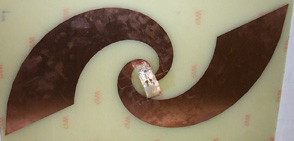The spiral research team
The research team is part of the Antenna and Electromagnetics Group at the Department of Electromagnetic Systems. The following persons are currently involved in the project:
- Jesper Thaysen (Ph.D. student)
- Kaj B. Jakobsen (Associate professor)
Funding
Radio-Parts Fonden, Copenhagen, Denmark is acknowledged for supporting major parts of this work.
Background
- 110 million buried explosive objects worldwide Anti-tank mines, anti-personal mines, rockets, etc.
- Additional an estimated 250 million mines are in stockpile Terrorists, Russia, United States of America, China, Italy, etc.
- When 1 mine is neutralised somebody lay out 20 new mines Soldiers and terrorists using cheap non-metallic objects, cost only a few US-Dollar
The Spiral antenna Research Project 
A cavity backed coplanar waveguide to coplanar strip - fed logarithmic uniplanar spiral antenna, which covers a 9 to 1 bandwidth with a return loss better than 10 dB from 0.4 to 3.8 GHz.
The fabricated antenna is a planar logarithmic spiral antenna printed on a 1.5 mm thick FR-4 substrate with a size of 220 x 430 mm and a relative dielectric constant er of 4.4. Each of the two spiral arms, that combined act as a balanced spiral antenna, was designed using the equations, r1=r0*exp(a*q) and r2=r0*exp(a*(q-q0)), where r1 and r2 are the outer and inner radii of the spirals, respectively; r0 and r0*exp(-a*q0), are the initial outer and inner radii, respectively; a is the growth rate, and q is the angular position.
 A developed wideband balun is used to accomplish the transition from the unbalanced CPW transmission line to the balanced CPS transmission line.
A developed wideband balun is used to accomplish the transition from the unbalanced CPW transmission line to the balanced CPS transmission line.
To aid the balun and antenna design, a method of moment computer program, was used to predict the performance of the spiral antenna in terms of the scattering parameters, the input impedance as well as the current distribution on the metallic surface and the radiation pattern. The scattering parameters as well as the radiation parameters are measured which confirm the validity of the simulated analysis.
 The shown average current density for the spiral antenna is found using IE3D. The red and the blue color indicate the areas with the highest and the lowest current density, respectively.
The shown average current density for the spiral antenna is found using IE3D. The red and the blue color indicate the areas with the highest and the lowest current density, respectively.
Successful detection of a buried non-metallic plastic object
The figures show the measured raw data. No additional signal processing has been used.
The presented data were collected at a large-scale indoor test facility at the Swedish Defence Research establishment (FOA). At DTU a similar experimental GPR setup are currently under construction. For the set-up the antenna was stepped 10 mm in both x and y-directions, resulting in 2601 measurement points for a total scan area of 500 x 500 mm.
Some of the above-mentioned topics (signal processing) are subject to current research whereas others are to be investigated as soon as qualified candidates have been found.
For further details
please contact Kaj B. Jakobsen at: kbj@oersted.dtu.dk.
Publications
Papers on spiral antennas and imaging with application to stepped frequency ground penetrating radar
- J. Thaysen, K. B. Jakobsen, and J. Appel-Hansen, "Circular polarised stepped frequency ground penetrating radar for humanitarian demining". SPIE's 15th Annual International Symposium, Orlando, Florida, USA, pp. 9, April 2001.
- J. Thaysen, K. B. Jakobsen, and J. Appel-Hansen, "Ultra wideband coplanar waveguide fed spiral antenna for humanitarian demining". Proc. 30th European Microwave Conference, CNIT, La Defense, Paris, pp. 371-375, Oct. 2-5, 2000.
Papers on spiral antennas and wideband baluns
- J. Thaysen, K. B. Jakobsen, and J. Appel-Hansen, "A wideband balun - how does it work?", More Practical Filters and Couplers: A Collection from Applied Microwave & Wireless, Noble Publishing Coorporation, ISBN 1-884932-31-2, pp. 77-82, 2002.
- J. Thaysen, J. Appel-Hansen, and K. B. Jakobsen, "The radiation pattern of a logarithmic spiral antenna". 2001 URSI International Symposium on Electromagnetic Theory, Victoria, British Columbia, Canada, pp. 25-28, May 2001.
- J. Thaysen, K. B. Jakobsen, and J. Appel-Hansen, "A logarithmic spiral antenna for 0.4 to 3.8 GHz". Applied Microwave & Wireless, pp. 32-45, Feb. 2001.
- J. Thaysen, K. B. Jakobsen, and J. Appel-Hansen, "Characterisation and optimisation of a coplanar waveguide fed logarithmic spiral antenna". Proc. IEEE AP-S Conference on Antennas and Propagation for Wireless Communication, Waltham, Mass., USA, pp. 25-28, Nov. 6-8, 2000.
- J. Thaysen, K. B. Jakobsen, and J. Appel-Hansen, "A wideband balun - how does it work?". Applied Microwave & Wireless, pp. 40-50, Oct. 2000.
- J. Thaysen, K. B. Jakobsen, and J. Appel-Hansen, "Numerical and experimental investigation of a coplanar waveguide fed spiral antenna", Proc. 24th QMW Antenna Symposium, Queen Mary and Westfield College, Univ. of London, pp. 13-16, April 18, 2000.
[Back to Research projects]